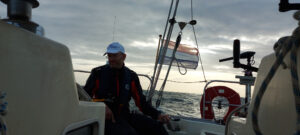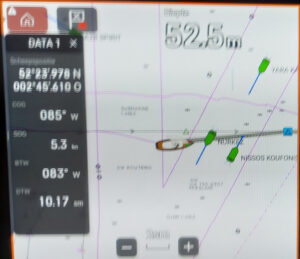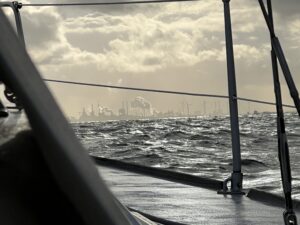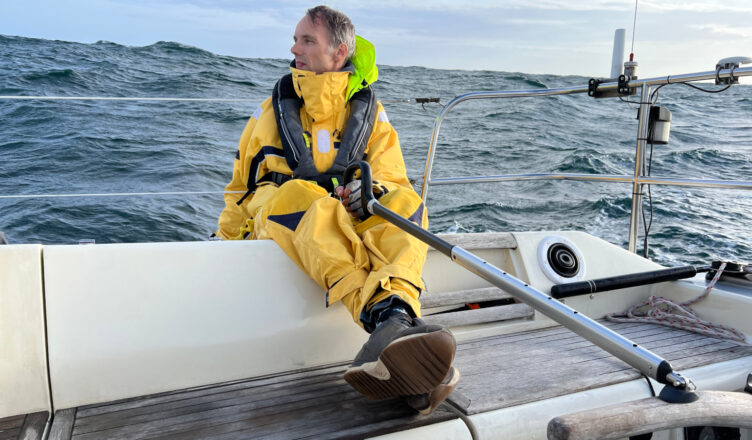After breakfast we make a voyage plan again and a checklist for this morning. I checked the diesel, it seems that we only used 20 liters. That is very little for 9.5 hours, probably a little more since the top of the tank is not measured. But at least we don’t have to refuel and simply add a 10 and 5 liter jerry can. Yesterday we went already to the supermarket for bread and cakes, so we’re all set.
In the voyage plan we use high tide reference Hoek van Holland and then revert the inbound voyage plan. We also allocated the watches so that those with shipping lanes crossing will be on my watch. That doesn’t turn out to be useful afterwards: for shipping lanes you need hands on the helm and eyes on the chart table. Especially with much wind and waves, you don’t want to be depended on the autohelm. On the list was also a walk to the pier for real live experience of the the wind. Maybe the main sail can be used after rounding the outer buoy. The wind is east. We can depart. Ask Port Control for permission to enter the harbour, which is granted shortly.
Offshore it soon turns out that the main sail would be way to much. It is already a solid 4 bft, unfortunately still SE. The wind will increase is the forecast and also what we experience. It’s not the furling genoa that’s on it, we didn’t really think about that. This genua can be rolled up, but it is very bad for the shape of the genoa as it get’s overstretched. However it really needs to be rolled up by 50%. Because we sail on the port side, that is a challenge. The sheet must remain on the winch to be able to release smoothly. However, the furling jib line must also be on a winch to overtake. I use the winch for the halyard. Slowly release the sheet and tighten the furling jib line. There is a gigantic power on both of them. We sail 6.0 knots and the nose is almost pushed into the waves. It does not work. I swear, which Dannes notes (in retrospect) that something is really going on, because I don’t do that very often. The furling jib line is off the drum. I need to go to the foredeck to fix this. And it should work, we have way too much sail. Very carefully, double-secured, I go to the foredeck, while Dannes keeps a relatively calm course on the boat. Despite the waves washing over the deck, the swell, I feel pretty confident on the foredeck and can fix the problem with a reasonable effort.
 Back in the cockpit we manage to roll in the genoa. Even with 50% sail we keep sailing at 6 knots, but no longer dive into the waves. This is going well. The wind has now increased to 5 Beaufort. We have to accept that nature is in charge and strangely enough we get used to all the violence, especially the high waves. However, it remains scary when breakers occur. Dannes has trouble orienting himself. Doesn’t dance with the waves yet, but focuses very much on the compass. Also not feeling well. When he is inside to put on dry clothes, things go wrong and he vomits. The seasickness came into play, despite medication. Fortunately, it is also over after that and outside at the helm is the best medicine to stay that way.
Back in the cockpit we manage to roll in the genoa. Even with 50% sail we keep sailing at 6 knots, but no longer dive into the waves. This is going well. The wind has now increased to 5 Beaufort. We have to accept that nature is in charge and strangely enough we get used to all the violence, especially the high waves. However, it remains scary when breakers occur. Dannes has trouble orienting himself. Doesn’t dance with the waves yet, but focuses very much on the compass. Also not feeling well. When he is inside to put on dry clothes, things go wrong and he vomits. The seasickness came into play, despite medication. Fortunately, it is also over after that and outside at the helm is the best medicine to stay that way.
I do need to get alternated, because steering is physically demanding, even when you actually keeps the helm as little moved as possible and the waves are tiring. We speed across at 6 knots and soon we are 3 hours ahead of schedule. We (re)interpret the waiting schedule: the next waypoint is the alternation of the watch, so not only after 2 hours. Then we will at least be fine with the shipping lanes. Also shorter watches is nice. When I see that Dannes has got the feeling back, I go to rest a bit, but with a sailing suit on and in the cabin. Point of attention for next time, how to prevent wet benches with salt water…

At the 2nd shipping lane I contact a large container ship to clarify our intentions, namely that we are going behind.
“You want to meet starboard to starboard sir?”, Yes, that’s correct, I respond.
“I will change my course a bit to port side.” That’s perfect, thank you. Have a nice watch.
After less than a minute I see on the plotter that this very big boy in front of us changes course by 10 degrees and sails to the left in the shipping lane. I steer slightly to the north, but soon I can go “straight ahead” again (due east). We go well behind and also have enough space to pass in front of the next ship.
When I have a look again at the image (left), I do not remember what the ship coming from the south did with the ship from the north that changed course for me. I believe it changed to course 0, at least we passed that one behind as well. The blue lines indicates 12 minutes ahead position. Our speed is usually 1/2 or 1/3rd of theirs. It gives me confidence that both the AIS and the VHF (crystal clear) have good reception and you are not completely alone. Although another ship “nearby” is at least 2 kilometres away if you convert to in landlubbers language.
It is still dark when we reach the IJmuiden Crossing. I report to IJmuiden Approach on VHF 7, pass on our route, stay south of TSS and that we continue to listen. When you have land in sight, you think: we’re almost there. Every time I fall for it again. However, it never true. We still have to sail for at least 3 hours.

The mobile network is available, so some messages at the home front: we’re almost back. Don’t mess up now. I’m taking some haze naps. The south pier gets quite a few waves and I have to steer Folly away from it quite a bit and go almost in the middle between the north and south pier. Fortunately, there is no other shipping, so we have the space.
On the beach – inside the piers, near the “houses” – just after the marina a sailing yacht has washed up. Looks like a whale on dry land. A sad face. Just happened? I see people walking around it. Engine breakdown, wrong route to
We arrive at the lock at 9:30 am and with little gradient we pass through to fresh water. Another short sail and around 12:00 we moor at Amsterdam Marina. Tired. Looking back on a successful crossing.
